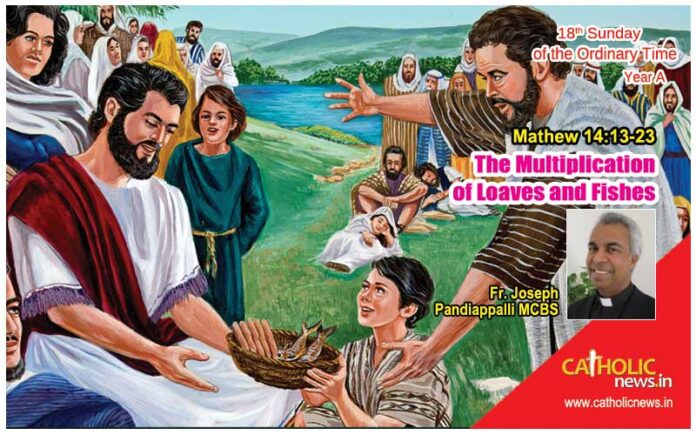
As I read the story of the multiplication of bread and its different explanations I came to the conclusion that the message of this miracle is the following: Jesus wanted to give food to the hungry people.
In the beginning of the gospel we heard that Jesus actually wanted to go to a lonley place to be alone. He was shocked and was very sad about the news of the beheadding of John the Baptist. But as the people went after Jesus and they found his place of stay he was very merciful. So he healed the sick and preached the coming of the kingdom of God giving them hope. As the people were hungry by the evening he gave them bread and fish to eat. This healing of the sick and the multiplication of bread belong to the many miracles of Jesus. But actually here the theme is not the miracles of Jesus, but Jesus’s help and support to the sick and hungry. If medicine and food were available there Jesus probably did not have to do miracles. Jesus was ready even to do miracles to heal the sick and to satisfy the hungry with food.
It is natural and human that people hope of a wonder when all the possible ways for the solution of problems or satisfaction of needs seem not to work. Some times we experience that in such a situation a wonder happens. Today many people suffer from hunger, war and sickness for which solutions are needed.
To the question whether we have tried everything to find solutions to such problems, the answer may be negative. We have not done everything. Many suffering people are desperate and about to loose their hope. Just as Jesus looked up to heaven and praised God we also can hope for a wonder to solve the problem of hunger and suffering after we have done everything to solve the problems.
Jesus satisfied five thousand hungry people with five bread and two fishes. Children and women were not counted to this five thousand. It is probable that there were more women present there than men to hear the preaching of Jesus and to experience his deeds. That means Jesus satisfied thousands of people with five bread and two fish. I tried to imagine how much place was needed to make these thousands of people to sit down, how difficult to organize even the supply of bead and fish to so many people, how many people would be involved in serving, how difficult was to hear Jesus in that period without modern techniques like microphone and laud speaker.
It was possible at that time to Organizer such events very spontaneously which we do it today with much planing ang organisation. I think these people could not hear everything what Jesus taught. They did not experience everything that took place there. It was important for them to be there and have the feeling of belongingness.
There is an allegorical interpretation of this miracle. According to the allegorical interpretation the five bread stand for the five Books of Moses, 12 baskets for 12 Apostles. Such allegorical interpretations are neither real nor reasonable. It is better to understand this miracle from the point of view of the love and mercy of Jesus towards the poor, sick, needy and the suffering people.
As Jesus served the poor and the needy we are invited to be merciful towards the week, suffering, poor and needy.
Fr. Joseph Pandiappallil MCBS



